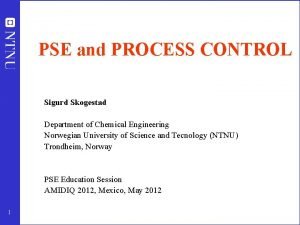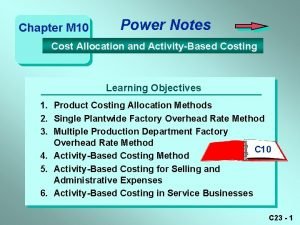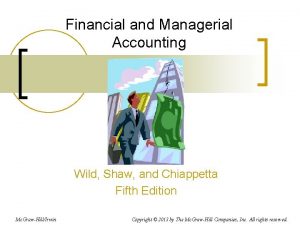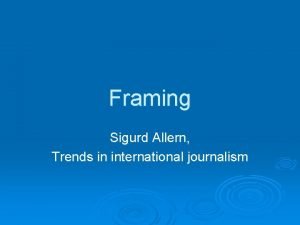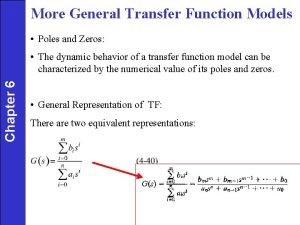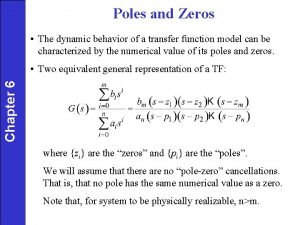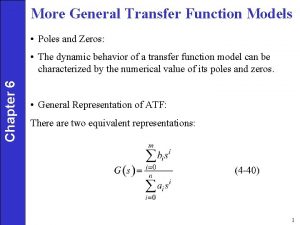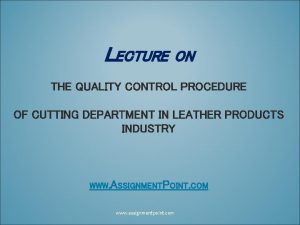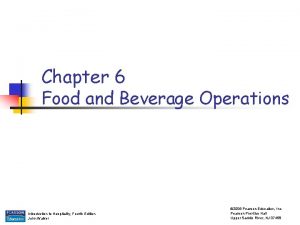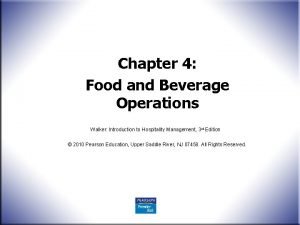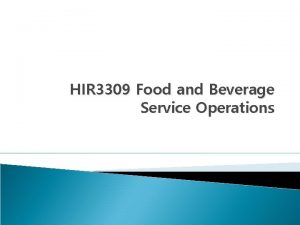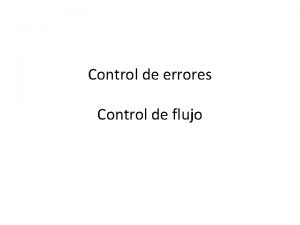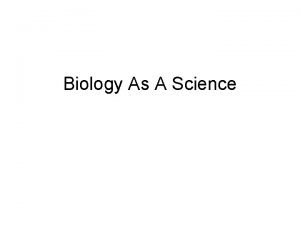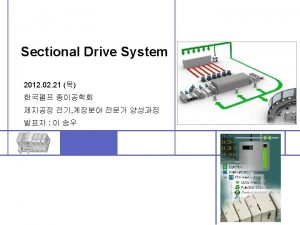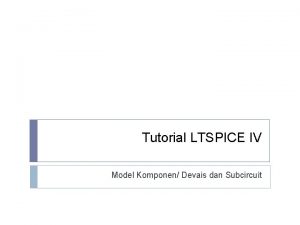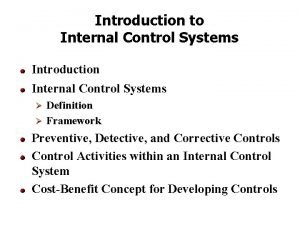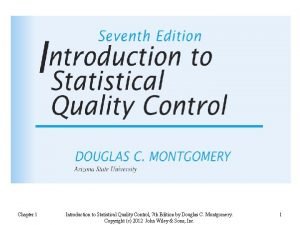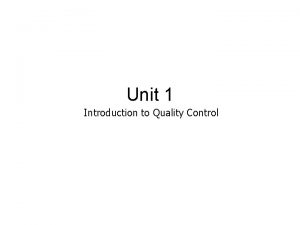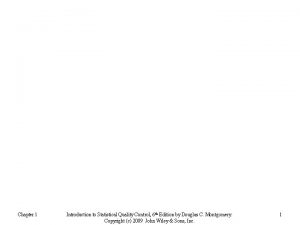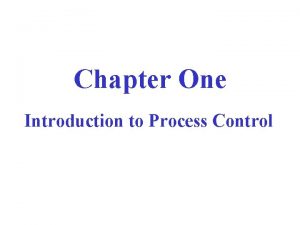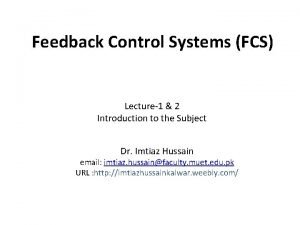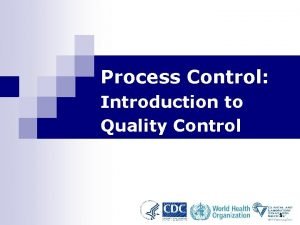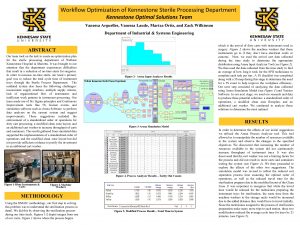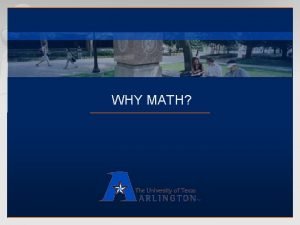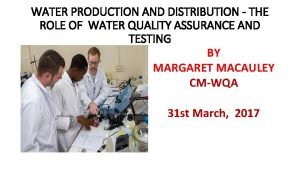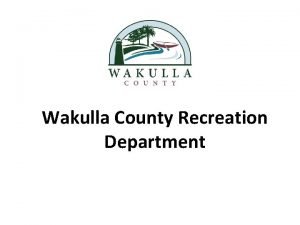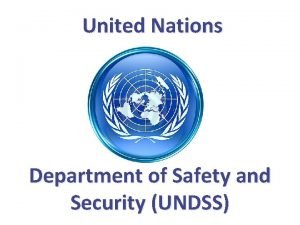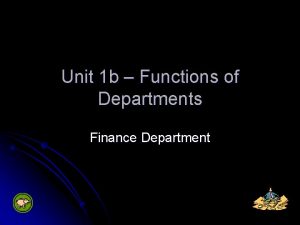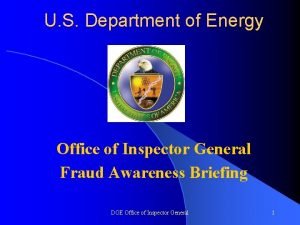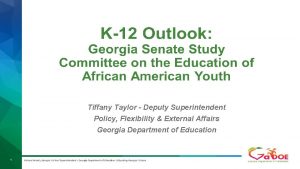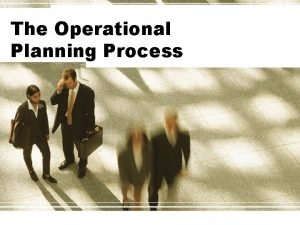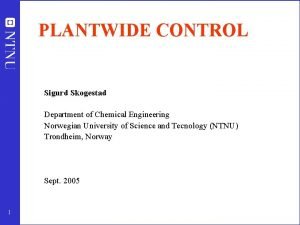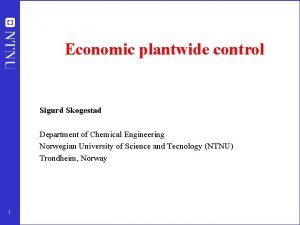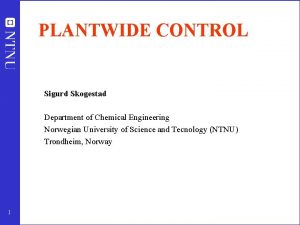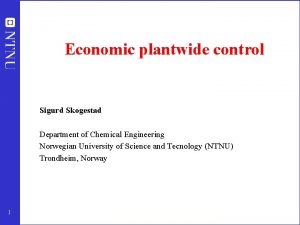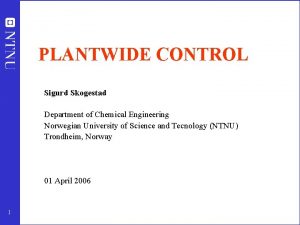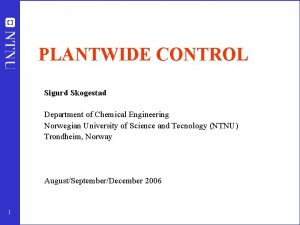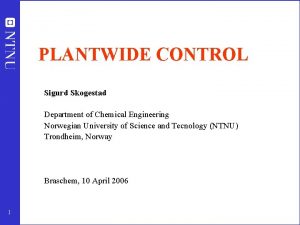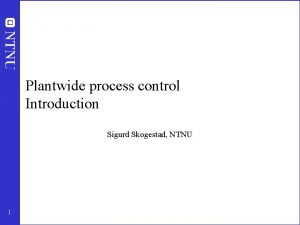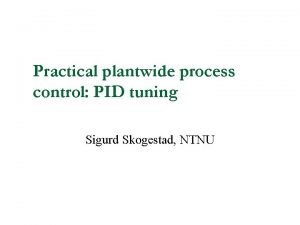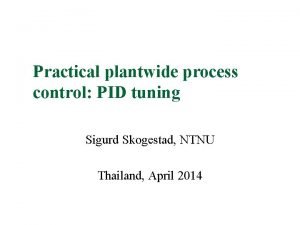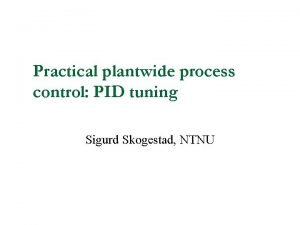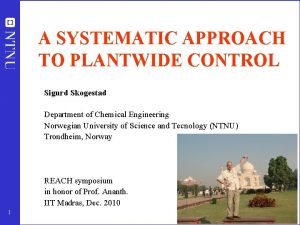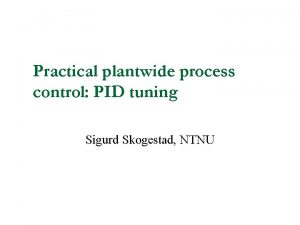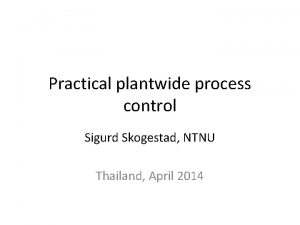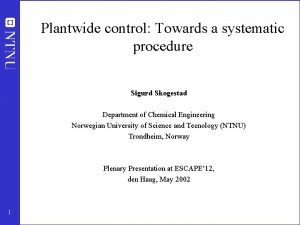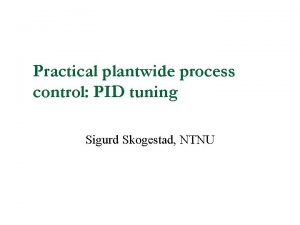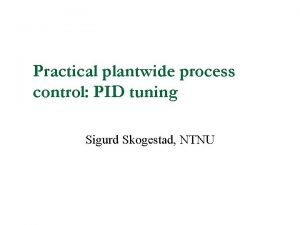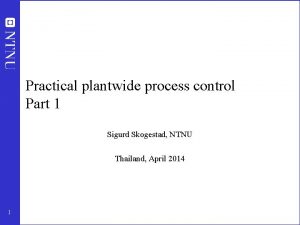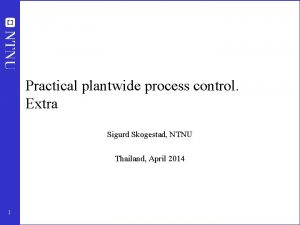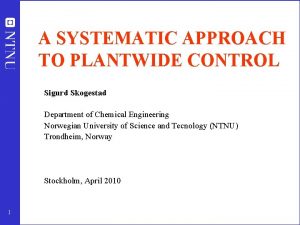AN INTRODUCTION TO PLANTWIDE CONTROL Sigurd Skogestad Department




















































- Slides: 52

AN INTRODUCTION TO PLANTWIDE CONTROL Sigurd Skogestad Department of Chemical Engineering Norwegian University of Science and Tecnology (NTNU) Trondheim, Norway Bratislava, jan. 2011 1

Arctic circle North Sea Trondheim NORWAY SWEDEN Oslo DENMARK GERMANY UK 3

NTNU, Trondheim 4

Plantwide control intro course: Contents • • • 5 Overview of plantwide control Step 1 -3. Selection of primary controlled variables based on economic : The link between the optimization (RTO) and the control (MPC; PID) layers - Degrees of freedom - Optimization - Self-optimizing control - Applications - Many examples Step 4. Where to set the production rate and bottleneck Step 5. Design of the regulatory control layer ("what more should we control") - stabilization - secondary controlled variables (measurements) - pairing with inputs - controllability analysis - cascade control and time scale separation. Step 6. Design of supervisory control layer - Decentralized versus centralized (MPC) - Design of decentralized controllers: Sequential and independent design - Pairing and RGA-analysis Summary and case studies

Dealing with complexity Main simplification: Hierarchical decomposition The controlled variables (CVs) interconnect the layers Process control OBJECTIVE Min J (economics); MV=y 1 s RTO cs = y 1 s MPC other variables) y 2 s PID 6 Follow path (+ look after CV=y 1 (+ u); MV=y 2 s Stabilize + avoid drift CV=y 2; MV=u u (valves)

Main message • 1. Control for economics (Top-down steady-state arguments) – Primary controlled variables c = y 1 : • • • Control active constraints For remaining unconstrained degrees of freedom: Look for “self-optimizing” variables 2. Control for stabilization (Bottom-up; regulatory PID control) – Secondary controlled variables y 2 (“inner cascade loops”) • • 7 Control variables which otherwise may “drift” Both cases: Control “sensitive” variables (with a large gain)!

Outline • Control structure design (plantwide control) • A procedure for control structure design I Top Down • • Step 1: Define optimal operation Step 2: Identify degrees of freedom and optimize for expected disturbances Step 3: What to control ? (primary CV’s) (self-optimizing control) Step 4: Where set the production rate? (Inventory control) II Bottom Up • Step 5: Regulatory control: What more to control (secondary CV’s) ? • Step 6: Supervisory control • Step 7: Real-time optimization 8

Idealized view of control (“Ph. D. control”) 9

Practice: Tennessee Eastman challenge problem (Downs, 1991) (“PID control”) 10

How we design a control system for a complete chemical plant? • • 11 Where do we start? What should we control? and why? etc.

• Alan Foss (“Critique of chemical process control theory”, AICh. E Journal, 1973): The central issue to be resolved. . . is the determination of control system structure. Which variables should be measured, which inputs should be manipulated and which links should be made between the two sets? There is more than a suspicion that the work of a genius is needed here, for without it the control configuration problem will likely remain in a primitive, hazily stated and wholly unmanageable form. The gap is present indeed, but contrary to the views of many, it is theoretician who must close it. • Carl Nett (1989): Minimize control system complexity subject to the achievement of accuracy specifications in the face of uncertainty. 12

Plantwide control = Control structure design • Not the tuning and behavior of each control loop, • But rather the control philosophy of the overall plant with emphasis on the structural decisions: – – Selection of controlled variables (“outputs”) Selection of manipulated variables (“inputs”) Selection of (extra) measurements Selection of control configuration (structure of overall controller that interconnects the controlled, manipulated and measured variables) – Selection of controller type (LQG, H-infinity, PID, decoupler, MPC etc. ). Previous work on plantwide control: 13 • Page Buckley (1964) - Chapter on “Overall process control” (still industrial practice) • Greg Shinskey (1967) – process control systems • Alan Foss (1973) - control system structure • Bill Luyben et al. (1975 - ) – case studies ; “snowball effect” • George Stephanopoulos and Manfred Morari (1980) – synthesis of control structures for chemical processes • Ruel Shinnar (1981 - ) - “dominant variables” • Jim Downs (1991) - Tennessee Eastman challenge problem • Larsson and Skogestad (2000): Review of plantwide control

Control structure design procedure I Top Down • Step 1: Define operational objectives (optimal operation) – Cost function J (to be minimized) – Operational constraints • Step 2: Identify degrees of freedom (MVs) and optimize for expected disturbances • Step 3: Select primary controlled variables c=y 1 (CVs) • Step 4: Where set the production rate? (Inventory control) II Bottom Up • Step 5: Regulatory / stabilizing control (PID layer) – What more to control (y 2; local CVs)? – Pairing of inputs and outputs • Step 6: Supervisory control (MPC layer) • Step 7: Real-time optimization (Do we need it? ) 14 y 1 y 2 MVs Process

Step 1. Define optimal operation (economics) • • What are we going to use our degrees of freedom u (MVs) for? Define scalar cost function J(u, x, d) – u: degrees of freedom (usually steady-state) – d: disturbances – x: states (internal variables) Typical cost function: J = cost feed + cost energy – value products • Optimize operation with respect to u for given d (usually steady-state): minu J(u, x, d) subject to: Model equations: f(u, x, d) = 0 Operational constraints: g(u, x, d) < 0 15

Step 2: Identify degrees of freedom and optimize for expected disturbances • Optimization: Identify regions of active constraints • Time consuming! Control 3 active constraints 3 16 0 1 2 2 1 3 unconstrained degrees of freedom -> Find 3 CVs

Step 3: Implementation of optimal operation • Optimal operation for given d*: minu J(u, x, d) subject to: Model equations: Operational constraints: → uopt(d*) f(u, x, d) = 0 g(u, x, d) < 0 Problem: Usally cannot keep uopt constant because disturbances d change How should we adjust the degrees of freedom (u)? 17

Implementation (in practice): Local feedback control! y “Self-optimizing control: ” Constant setpoints for c gives acceptable loss d 18 Local feedback: Control c (CV) Optimizing control Feedforward

Question: What should we control (c)? (primary controlled variables y 1=c) Issue: What should we control? • Introductory example: Runner 19

Optimal operation - Runner Optimal operation of runner – Cost to be minimized, J=T – One degree of freedom (u=power) – What should we control? 20

Optimal operation - Runner Sprinter (100 m) • 1. Optimal operation of Sprinter, J=T – Active constraint control: • Maximum speed (”no thinking required”) 21

Optimal operation - Runner Marathon (40 km) • 2. Optimal operation of Marathon runner, J=T • Unconstrained optimum! • Any ”self-optimizing” variable c (to control at constant setpoint)? • • 22 c 1 = distance to leader of race c 2 = speed c 3 = heart rate c 4 = level of lactate in muscles

Optimal operation - Runner Conclusion Marathon runner select one measurement c = heart rate 23 • Simple and robust implementation • Disturbances are indirectly handled by keeping a constant heart rate • May have infrequent adjustment of setpoint (heart rate)

Step 3. What should we control (c)? c=Hy y – available measurements (including u’s) H – selection of combination matrix What should we control? Equivalently: What should H be? 1. Control active constraints! 2. Unconstrained variables: Control self-optimizing variables! 24

Expected active constraints distillation 1. Valuable product: Purity spec. always active – Reason: Amount of valuable product (D or B) should always be maximized • Avoid product “give-away” (“Sell water as methanol”) • Also saves energy • valuable product methanol + max. 1% water Control implications valuable product: Control purityat spec. 2. “Cheap” product. May want to over-purify! Trade-off: – Yes, increased recovery of valuable product (less loss) – No, costs energy May give unconstrained optimum 25 methanol + water cheap product (byproduct) water + max. 0. 5% methanol

1. CONTROL ACTIVE CONSTRAINTS! • Active input constraints: Just set at MAX or MIN • Active output constraints: Need back-off c ≥ cconstraint J Jopt Back-off c a) If constraint can be violated dynamically (only average matters) • b) Required Back-off = “bias” (steady-state measurement error for c) If constraint cannot be violated dynamically (“hard constraint”) • 26 Loss Required Back-off = “bias” + maximum dynamic control error Want tight control of hard output constraints to reduce the back-off “Squeeze and shift”

Example. Optimal operation = max. throughput. Want tight bottleneck control to reduce backoff! Back-off = Lost production Time 27 Rule for control of hard output constraints: “Squeeze and shift”! Reduce variance (“Squeeze”) and “shift” setpoint cs to reduce backoff

Unconstrained degrees of freedom Control “self-optimizing” variables 1. Old idea (Morari et al. , 1980): “We want to find a function c of the process variables which when held constant, leads automatically to the optimal adjustments of the manipulated variables, and with it, the optimal operating conditions. ” 2. “Self-optimizing control” = acceptable steady-state behavior (loss) with constant CVs. is similar to “Self-regulation” = acceptable dynamic behavior with constant MVs. 3. The ideal self-optimizing variable c is the gradient (c = J/ u = Ju) 30 – Keep gradient at zero for all disturbances (c = Ju=0) – Problem: no measurement of gradient

H 31

H 32

Guidelines for selecting single measurements as CVs • Rule 1: The optimal value for CV (c=Hy) should be insensitive to disturbances d (minimizes effect of setpoint error) • Rule 2: c should be easy to measure and control (small implementation error n) • Rule 3: “Maximum gain rule”: c should be sensitive to changes in u (large gain |G| from u to c) or equivalently the optimum Jopt should be flat with respect to c (minimizes effect of implementation error n) 33 Reference: S. Skogestad, “Plantwide control: The search for the self-optimizing control structure”, Journal of Process Control, 10, 487 -507 (2000).

Optimal measurement combination • Candidate measurements (y): Include also inputs u H 34

No measurement noise (n=0) Nullspace method 35

With measurement noise Optimal measurement combination, c = Hy cs = constant + - K u + + c + y + H “=0” in nullspace method (no noise) “Minimize” in Maximum gain rule ( maximize S 1 G Juu-1/2 , G=HGy ) 37 “Scaling” S 1

Example: CO 2 refrigeration cycle J = W s (work supplied) DOF = u (valve opening, z) Main disturbances: d 1 = T H d 2 = T Cs (setpoint) d 3 = UA loss What should we control? 39 p. H

CO 2 refrigeration cycle Step 1. One (remaining) degree of freedom (u=z) Step 2. Objective function. J = Ws (compressor work) Step 3. Optimize operation for disturbances (d 1=TC, d 2=TH, d 3=UA) • Optimum always unconstrained Step 4. Implementation of optimal operation • No good single measurements (all give large losses): – ph, Th, z, … • Nullspace method: Need to combine nu+nd=1+3=4 measurements to have zero disturbance loss • Simpler: Try combining two measurements. Exact local method: – c = h 1 ph + h 2 Th = ph + k Th; k = -8. 53 bar/K • Nonlinear evaluation of loss: OK! 40

CO 2 cycle: Maximum gain rule 41

Refrigeration cycle: Proposed control structure 42 Control c= “temperature-corrected high pressure”

Step 4. Where set production rate? • • • 43 Where locale the TPM (throughput manipulator)? Very important! Determines structure of remaining inventory (level) control system Set production rate at (dynamic) bottleneck Link between Top-down and Bottom-up parts

TPM (Throughput manipulator) • TPM (Throughput manipulator)= ”Unused” degree of freedom that affects the throughput. • Definition (Aske and Skogestad, 2009). A TPM is a degree of freedom that affects the network flow and which is not directly or indirectly determined by the control of the individual units, including their inventory control. • Usually set by the operator (manual control), often the main feedrate 45

Production rate set at inlet : Inventory control in direction of flow* TPM * Required to get “local-consistent” inventory control 49

Production rate set at outlet: Inventory control opposite flow TPM 50

Production rate set inside process TPM 51

Step 5: Regulatory control layer Step 5. Choose structure of regulatory (stabilizing) layer (a) Identify “stabilizing” CV 2 s (levels, pressures, reactortemperature, one temperature in each column, etc. ). In addition, active constraints (CV 1) that require tight control (small backoff) may be assigned to the regulatory layer. (Comment: usually not necessary with tight control of unconstrained CVs because optimum is usually relatively flat) (b) Identify pairings (MVs to be used to control CV 2), taking into account – Want “local consistency” for the inventory control – Want tight control of important active constraints – Avoid MVs that may saturate in the regulatory layer, because this would require either • reassigning the regulatory loop (complication penalty), or • requiring back-off for the MV variable (economic penalty) Preferably, the same regulatory layer should be used for all operating regions without the need for reassigning inputs or outputs. 52

Rules for pairing of variables and choice of control structure Main rule: “Pair close” 1. The response (from input to output) should be fast, large and in one direction. Avoid dead time and inverse responses! 2. The input (MV) should preferably effect only one output (to avoid interaction between the loops) 3. Try to avoid input saturation (valve fully open or closed) in “basic” control loops for level and pressure 4. The measurement of the output y should be fast and accurate. It should be located close to the input (MV) and to important disturbances. • Use extra measurements y’ and cascade control if this is not satisfied 5. The system should be simple • 53 Avoid too many feedforward and cascade loops 6. “Obvious” loops (for example, for level and pressure) should be closed first before you spend to much time on deriving process matrices etc.

Example: Distillation • Primary controlled variable: y 1 = c = x. D, x. B (compositions top, bottom) • BUT: Delay in measurement of x + unreliable • Regulatory control: For “stabilization” need control of (y 2): – – Liquid level condenser (MD) Unstable (Integrating) + No steady-state effect Liquid level reboiler (MB) Pressure (p) Variations in p disturb other loops Holdup of light component in column (temperature profile) Almost unstable (integrating) Ts 54 T-loop in bottom TC

Why simplified configurations? Why control layers? Why not one “big” multivariable controller? • Fundamental: Save on modelling effort • Other: – – – 55 easy to understand easy to tune and retune insensitive to model uncertainty possible to design for failure tolerance fewer links reduced computation load

Degrees of freedom unchanged • No degrees of freedom lost by control of secondary (local) variables as setpoints become y 2 s replace inputs u 2 as new degrees of freedom Cascade control: y 2 s New DOF 56 K u 2 G y 1 y 2 Original DOF

”Advanced control” STEP 6. SUPERVISORY LAYER Objectives of supervisory layer: 1. Switch control structures(CV 1) depending on operating region • • Active constraints self-optimizing variables 2. Perform “advanced” economic/coordination control tasks. – Control primary variables CV 1 at setpoint using as degrees of freedom (MV): • • – Keep an eye on stabilizing layer • – 57 Avoid saturation in stabilizing layer Feedforward from disturbances • – – Setpoints to the regulatory layer (CV 2 s) ”unused” degrees of freedom (valves) If helpful Make use of extra inputs Make use of extra measurements Implementation: • Alternative 1: Advanced control based on ”simple elements” • Alternative 2: MPC

Control configuration elements • Control configuration. The restrictions imposed on the overall controller by decomposing it into a set of local controllers (subcontrollers, units, elements, blocks) with predetermined links and with a possibly predetermined design sequence where subcontrollers are designed locally. Some control configuration elements: • Cascade controllers • Decentralized controllers • Feedforward elements • Decoupling elements • Selectors • Split-range control 58

Summary. Systematic procedure for plantwide control 1. Start “top-down” with economics: – – – 2. Step 1: Identify degrees of freeedom Step 2: Define operational objectives and optimize steady-state operation. Step 3 A: Identify active constraints = primary CVs c. Should be controlled to maximize profit) Step 3 B: For remaining unconstrained degrees of freedom: Select CV 1 s c based on self -optimizing control. Step 4: Where to set the throughput (usually: feed) Regulatory control I: Decide on how to move mass through the plant: • 3. 4. Step 6: “Advanced control” system (MPC): • • • 59 Step 5 B: Control variables CV 2 to stop “drift” (sensitive temperatures, pressures, . . ) – Pair variables to avoid interaction and saturation Finally: make link between “top-down” and “bottom up”. • CV 1 Step 5 A: Propose “local-consistent” inventory (level) control structure. Regulatory control II: “Bottom-up” stabilization of the plant • cs CVs: Active constraints and self-optimizing economic variables + look after variables in layer below (e. g. , avoid saturation) MVs: Setpoints to regulatory control layer. Coordinates within units and possibly between units CV 2

Summary and references • The following paper summarizes the procedure: – S. Skogestad, ``Control structure design for complete chemical plants'', Computers and Chemical Engineering, 28 (1 -2), 219 -234 (2004). • There are many approaches to plantwide control as discussed in the following review paper: – T. Larsson and S. Skogestad, ``Plantwide control: A review and a new design procedure'' Modeling, Identification and Control, 21, 209 -240 (2000). 60

• • • • • • 61 • • S. Skogestad ``Plantwide control: the search for the self-optimizing control structure'', J. Proc. Control, 10, 487 -507 (2000). S. Skogestad, ``Self-optimizing control: the missing link between steady-state optimization and control'', Comp. Chem. Engng. , 24, 569575 (2000). I. J. Halvorsen, M. Serra and S. Skogestad, ``Evaluation of self-optimising control structuresfor an integrated Petlyuk distillation column'', Hung. J. of Ind. Chem. , 28, 11 -15 (2000). T. Larsson, K. Hestetun, E. Hovland, and S. Skogestad, ``Self-Optimizing Control of a Large-Scale Plant: The Tennessee Eastman Process'', Ind. Eng. Chem. Res. , 40 (22), 4889 -4901 (2001). K. L. Wu, C. C. Yu, W. L. Luyben and S. Skogestad, ``Reactor/separatorprocesses with recycles-2. Design for composition control'', Comp. Chem. Engng. , 27 (3), 401 -421 (2003). T. Larsson, M. S. Govatsmark, S. Skogestad, and C. C. Yu, ``Control structureselection for reactor, separator andrecycle processes'', Ind. Eng. Chem. Res. , 42 (6), 1225 -1234 (2003). A. Faanes and S. Skogestad, ``Buffer Tank Design for Acceptable Control Performance'', Ind. Eng. Chem. Res. , 42 (10), 2198 -2208 (2003). I. J. Halvorsen, S. Skogestad, J. C. Morud and V. Alstad, ``Optimal selection of controlled variables'', Ind. Eng. Chem. Res. , 42 (14), 3273 -3284 (2003). A. Faanes and S. Skogestad, ``p. H-neutralization: integrated process and control design'', Computers and Chemical Engineering, 28 (8), 1475 -1487 (2004). S. Skogestad, ``Near-optimal operation by self-optimizing control: From process control to marathonrunning and business systems'', Computers and Chemical Engineering, 29 (1), 127 -137 (2004). E. S. Hori, S. Skogestad and V. Alstad, ``Perfect steady-state indirect control'', Ind. Eng. Chem. Res, 44 (4), 863 -867 (2005). M. S. Govatsmarkand S. Skogestad, ``Selection of controlled variables and robust setpoints'', Ind. Eng. Chem. Res, 44 (7), 2207 -2217 (2005). V. Alstad and S. Skogestad, ``Null Space Method for Selecting Optimal Measurement Combinations as. Controlled Variables'', Ind. Eng. Chem. Res, 46 (3), 846 -853 (2007). S. Skogestad, ``The dos and don'ts of distillation columns control'', Chemical Engineering Research and Design (Trans IChem. E, Part A), 85 (A 1), 13 -23 (2007). E. S. Hori and S. Skogestad, ``Selection of control structureand temperaturelocation for two-product distillation columns'', Chemical Engineering Research and Design (Trans IChem. E, Part A), 85 (A 3), 293 -306 (2007). A. C. B. Araujo, M. Govatsmarkand S. Skogestad, ``Application of plantwide control to the HDA process. I Steady-state and selfoptimizing control'', Control Engineering Practice, 15, 1222 -1237 (2007). A. C. B. Araujo, E. S. Hori and S. Skogestad, ``Application of plantwide control to the HDA process. Part IIRegulatory control'', Ind. Eng. Chem. Res, 46 (15), 5159 -5174 (2007). V. Kariwala, S. Skogestad and J. F. Forbes, ``Reply to ``Further. Theoretical results on Relative Gain Array for Norn-Bounded Uncertain systems''''Ind. Eng. Chem. Res, 46 (24), 8290 (2007). V. Lersbamrungsuk, T. Srinophakun, S. Narasimhanand S. Skogestad, ``Control structuredesign for optimal operation of heat exchanger networks'', AICh. E J. , 54 (1), 150 -162 (2008). DOI 10. 1002/aic. 11366 T. Lid and S. Skogestad, ``Scaled steady state models for effective on-line applications'', Computers and Chemical Engineering, 32, 990 -999 (2008). T. Lid and S. Skogestad, ``Data reconciliation and optimal operation of a catalytic naphthareformer'', Journal of Process Control, 18, 320 -331 (2008). E. M. B. Aske, S. Strand S. Skogestad, ``Coordinator. MPC for maximizing plant throughput'', Computers and Chemical Engineering, 32, 195 -204 (2008). A. Araujo and S. Skogestad, ``Control structuredesign for the ammonia synthesis process'', Computers and Chemical Engineering, 32 (12), 2920 -2932 (2008). E. S. Hori and S. Skogestad, ``Selection of controlled variables: Maximum gain rule and combination of measurements'', Ind. Eng. Chem. Res, 47 (23), 9465 -9471 (2008). V. Alstad, S. Skogestad and E. S. Hori, ``Optimal measurement combinations as controlled variables'', Journal of Process Control, 19, 138 -148 (2009) E. M. B. Aske and S. Skogestad, ``Consistent inventory control'', Ind. Eng. Chem. Res, 48 (44), 10892 -10902 (2009).
 Pse in p&id
Pse in p&id How to find plantwide overhead rate
How to find plantwide overhead rate Plantwide overhead rate method
Plantwide overhead rate method Sigurd allern
Sigurd allern Sigurd meldal
Sigurd meldal Sigurd allern
Sigurd allern Skogestad half rule
Skogestad half rule Skogestad half rule
Skogestad half rule Skogestad half rule example
Skogestad half rule example Quality control in cutting department
Quality control in cutting department Unit 6 food & beverage
Unit 6 food & beverage Introduction to food and beverage service department
Introduction to food and beverage service department Introduction to food and beverage service department
Introduction to food and beverage service department Introduction to food and beverage service department
Introduction to food and beverage service department Translational research institute on pain in later life
Translational research institute on pain in later life Process control and product control
Process control and product control Fluid mechanics
Fluid mechanics Stock control e flow control
Stock control e flow control Control volume vs control surface
Control volume vs control surface Positive vs negative controls
Positive vs negative controls What is a negative control in an experiment
What is a negative control in an experiment Jelaskan tentang error control pada data link control?
Jelaskan tentang error control pada data link control? Control de flujo y control de errores
Control de flujo y control de errores Negative control vs positive control examples
Negative control vs positive control examples Control flow errors
Control flow errors Scalar control vs vector control
Scalar control vs vector control Control c control v
Control c control v Introduction to internal control
Introduction to internal control Social control in sociology
Social control in sociology Montgomery quality control
Montgomery quality control Introduction to quality control
Introduction to quality control Internal control structure
Internal control structure Digital control
Digital control Introduction to digital control
Introduction to digital control Introduction to statistical quality control
Introduction to statistical quality control Introduction to process control
Introduction to process control Fcs control systems
Fcs control systems Introduction to quality control
Introduction to quality control Introduction paragraph structure
Introduction paragraph structure Sterile workflow optimization
Sterile workflow optimization Why strategic planning is important to all managers
Why strategic planning is important to all managers Uta maa
Uta maa Swot analysis for procurement department
Swot analysis for procurement department Objective of warehousing
Objective of warehousing Wakulla recreation park
Wakulla recreation park Amar telidji university
Amar telidji university Un department of safety and security
Un department of safety and security The finance department
The finance department Ucl computer science modules
Ucl computer science modules Doe oig
Doe oig Tiffany taylor georgia department of education
Tiffany taylor georgia department of education Function of marketing research
Function of marketing research Department operational plan
Department operational plan
